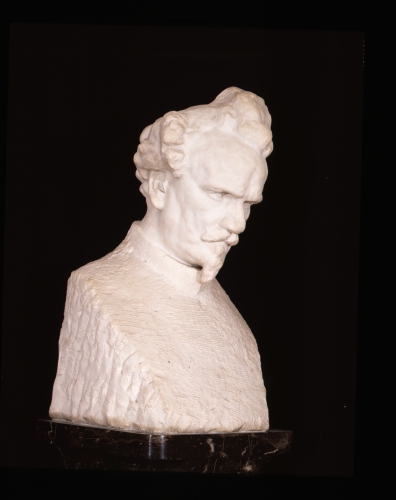During June and July this year, I had the exciting opportunity to work as an intern on the Collaborative Research Internship project ‘Auguste Rodin and Portraiture’, led by Dr Claire Jones from the Department of Art History, Curating and Visual Studies. As a History of Art student, myself, I was interested in studying Rodin and his work, since I had yet to do so in much depth, and I was also curious about the process of academic research. In this blog post, I will be giving a short summary of what the research project was about and discussing my experience as an intern: Was it what I expected? What was particularly interesting? How do I feel now about academic research?
The project was, as might be expected, all about Auguste Rodin and portraits that he had sculpted. Rodin was a very successful and widely admired French sculptor who worked during the second half of the nineteenth century and into the early twentieth century. Some of his most famous artworks include The Age of Bronze, The Thinker, and The Gates of Hell. The Barber Institute of Fine Arts on our campus currently has two of his sculptures on display – one large marble portrait bust of French politician and journalist Henri Rochefort, and one large, bronze statue of a life-sized nude man, The Age of Bronze. Claire’s project involved researching Henri Rochefort in particular, and investigating what has already been written about Rodin’s portrait busts. We considered questions such as: How did Rodin engage with portraiture? Whom did he sculpt, and why? Through which lenses have these works been studied, and what else should be considered? Ultimately, all of the research we did will go toward Claire’s future exhibition proposal for the Barber, in which one of the key exhibits would be the Henri Rochefort bust.

Going into this internship, I had correctly anticipated that I would be doing a lot of reading and note taking. I had expected to find it more difficult to understand the topic and contribute to the research because while I am an Art History student, I had not previously studied Rodin in any great depth. Thankfully, my expectations were proven wrong: Claire provided me with guidance and information from the start, answered all of the questions I had, and as the project developed, I found that I did have things to say and questions to ask that were beneficial one way or another. In that sense, I didn’t feel as out of my depth as I had worried I might.
I also found many aspects of the research project really interesting! Firstly, I enjoy visiting exhibitions and in my second year I took Claire’s ‘Inside the Gallery: Curating an Exhibition’ module, so I was really curious to see the research that goes into the early stages of planning an exhibition proposal. Secondly, I found Rodin and his work to be really fascinating. Specifically, I was intrigued when different threads became relevant or ideas that Claire and I had discussed but had been unable to substantiate presented themselves in a new light. To give an example, I was really interested in the connections we found between Henri Rochefort and The Age of Bronze, which raised questions about how the objects might be displayed in an exhibit, and which other objects could be displayed alongside them. Going into our research, we had not been aware of any immediate links. As it turns out, Rodin befriended a writer and journalist named Edmond Bazire, to whom he expressed his grief and frustration over the controversy surrounding The Age of Bronze, which had arisen after its first exhibition in 1877. Rodin had been wrongly accused of casting the sculpture from a real man, rather than sculpting it by hand himself, which cast doubt on his skills and reputation. Bazire suggested that to counter these rumours, Rodin should sculpt portraits of men whose temper was well known and whom the public were convinced would never allow themselves to be cast from life (a potentially unpleasant process for the sitter). He suggested two names: Victor Hugo, and Henri Rochefort. Rodin went on to sculpt busts of both men in the following years, through sittings which were in one way or other facilitated by Bazire. He later confided in his friend Judith Cladel, a French playwright, novelist, biographer and journalist, saying that he preferred his Hugo and Rochefort portrait busts to The Age of Bronze.
Overall, I would say that this internship has made me feel more positively about academic research. Some of my family have jobs involving research, so it wasn’t an entirely unfamiliar process to me, however it turns out that academic research is more enjoyable to take part in than to simply watch. I found it interesting and rewarding to do, and knowing my work is contributing to plans further down the line was gratifying. I was often having to reconsider what I had previously thought in favour of new information, which was great!
Do give the Barber a visit before they temporarily shut their gallery doors for refurbishment this October! And give Henri Rochefort a wave from me. Thank you for reading.
Giulia Leahy, BA History of Art
